The Local newsletter is your free, daily guide to life in Colorado. For locals, by locals.
Fugitive dust. Soil compaction. Reduced habitat connectivity. You’ll find these words and phrases—none of them with definitions that describe anything good—in nearly every environmental report you read about off-highway vehicle use. Whether the study is from the Bureau of Land Management or the U.S. Forest Service or another agency, the consensus is the pursuit has a detrimental effect on natural resources.
This, of course, shouldn’t be a surprise to Coloradans who have time and again witnessed that all recreational use—motorized or not—impacts nature’s ecosystems (see: Conundrum Hot Springs, Hanging Lake, and Mt. Bierstadt). But there’s no denying the fact that the negative impacts of one reckless OHV driver far exceed those of, say, one careless hiker. “Irresponsible OHV use results in damage to the land, soundscapes, and habitat—and creates conflict,” says Tom Sobal, director for the Quiet Use Coalition, a Chaffee County–based organization that works to create and protect nonmotorized uses on public lands. “Especially the use of OHVs off designated trails.”

As such, the Quiet Use Coalition has lobbied against the continued expansion of motorized access and what it sees as lax enforcement of OHV regulations by state and federal land managers. In some cases, their politicking has worked; in others, it hasn’t. Sobal says although there clearly isn’t a magic-wand remedy for all the ills he believes motorized use wreaks on flora, fauna, and humans seeking the refuge of the wilds, he says mandatory and/or increased education for all OHV operators in Colorado would help.

“That’s where Stay The Trail comes in,” says On Trail Training’s Matt Balazs, who also happens to be the former chairman and a current board member of nonprofit Stay The Trail, whose mission it is to reinforce conscientious OHV use. “We offer responsible-use education to people who are new to the state, new to the activity, or who just don’t know that what they’re doing is a problem.” Stay The Trail, whose name is its guiding principle, used 505 volunteer hours to make contact with more than 8,900 off-road-curious Coloradans in 2019. “We go to trailheads to educate people,” Balazs says. “We explain things like how alpine tundra vegetation is incredibly fragile and doesn’t regenerate well if tread on by off-roading tires.” Stay The Trail volunteers also participate in trail improvement projects; help disseminate educational materials at festivals around the state; and work with OHV owners to make sure their rides are compliant with Colorado sound laws.
That might not be as much education as Sobal has in mind, but it certainly doesn’t hurt. Plus, says Fletcher Jacobs, state trails program manager for the Department of Natural Resources, the pathways that motorized recreationists use are always multiuse—and OHV permit and registration fees pay for a lot of upkeep on paths that hikers, mountain bikers, and equestrians use for free. “Sharing the trails is important,” Jacobs says. “These are our avenues to getting to Colorado’s beautiful places. But there is an impact. From everyone. The easiest way to keep resource damage to a minimum is to stay on the trail, because it was built for and is maintained for the use.”
99 dBA: The maximum decibel level that an OHV may emit in Colorado. Anything louder is a violation of the 2008 Colorado Revised Statute 25-12-110. The Department of Natural Resources says noise complaints from the public are rare; however, those with sensitive ears like to note this level of sound is four times louder than the average car.








